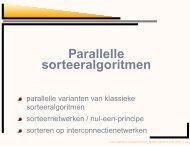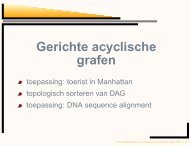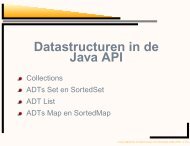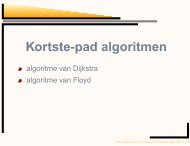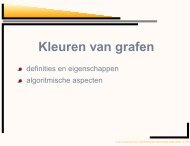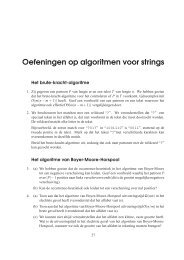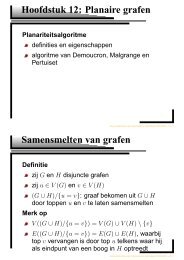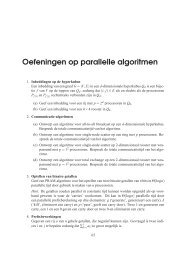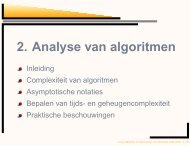Here - Combinatorial algorithms and algorithmic graph theory
Here - Combinatorial algorithms and algorithmic graph theory
Here - Combinatorial algorithms and algorithmic graph theory
Create successful ePaper yourself
Turn your PDF publications into a flip-book with our unique Google optimized e-Paper software.
12 Generation of cubic <strong>graph</strong>s<br />
(a) (b) (c)<br />
Figure 2.1: Some examples of cubic <strong>graph</strong>s: K 4, the Petersen <strong>graph</strong> <strong>and</strong> the C 60<br />
fullerene respectively.<br />
The class of cubic <strong>graph</strong>s is especially interesting for mathematical applications<br />
because for various important open problems in <strong>graph</strong> <strong>theory</strong>, the smallest<br />
or simplest possible potential counterexamples are cubic <strong>graph</strong>s (see Chapter 3<br />
for more information). In chemistry, cubic <strong>graph</strong>s serve as models for e.g. the<br />
Nobel Prize winning fullerenes [80] (see Chapter 4) or, more generally, for some<br />
cyclopolyenes [5].<br />
The generation of cubic <strong>graph</strong>s can be considered a benchmark problem in<br />
structure enumeration. The first complete lists of cubic connected <strong>graph</strong>s were<br />
given by de Vries at the end of the 19th century, who gave a list of all cubic (connected)<br />
<strong>graph</strong>s up to 10 vertices [42, 43]. The first computer approach was by<br />
Balaban, a theoretical chemist. He generated all cubic <strong>graph</strong>s up to 12 vertices<br />
in 1966/67 [5]. De Vries’ lists were independently confirmed by h<strong>and</strong> by Bussemaker<br />
<strong>and</strong> Seidel in 1968 [38] <strong>and</strong> Imrich in 1971 [70]. From 1974 on, various<br />
<strong>algorithms</strong> for the generation of cubic <strong>graph</strong>s were published. Each algorithm<br />
was implemented in a computer program that could generate larger lists of cubic<br />
<strong>graph</strong>s, see [97],[50],[37],[92],[11]. In 1983 Robinson <strong>and</strong> Wormald [106] published<br />
a paper on the non-constructive enumeration of cubic <strong>graph</strong>s.<br />
When present research began, the fastest publicly available program for the<br />
generation of cubic <strong>graph</strong>s was minibaum [11]. When developed in 1992, minibaum<br />
could be used to generate complete lists of all cubic <strong>graph</strong>s up to 24 vertices<br />
<strong>and</strong> several more restricted subclasses of cubic <strong>graph</strong>s with more vertices, like cubic<br />
bipartite <strong>graph</strong>s or cubic <strong>graph</strong>s with higher girth. Later, when more <strong>and</strong><br />
faster computers were available, minibaum was used to generate all cubic <strong>graph</strong>s<br />
up to 30 vertices in order to test them for Yutsis decompositions [2].<br />
In 1999, Meringer [95] published a very efficient algorithm for the generation



